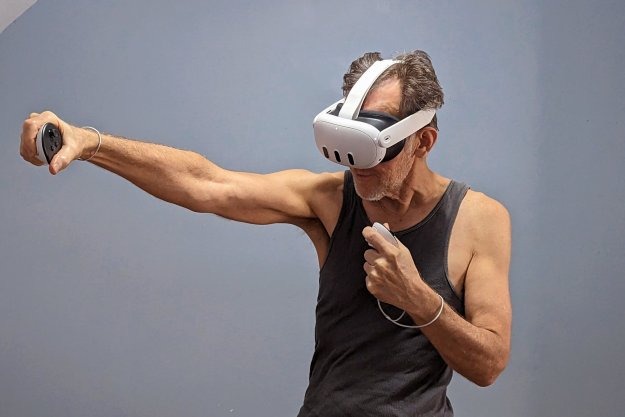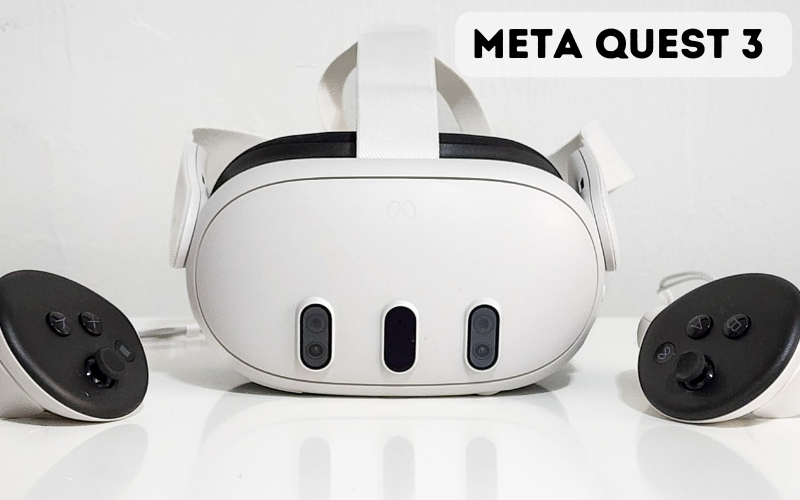He Meta Quest 3 was reviewed by various tech experts, highlighting its significant improvements over its predecessor, the Quest 2. This new virtual reality headset promises a more immersive experience, better performance, and enhanced comfort. Here’s a detailed look at what makes the Meta Quest 3 stand out in the crowded VR market.
Design and Comfort
The Meta Quest 3 retains a similar look to the Quest 2 but is noticeably more refined. It features a sleek white plastic shell and is slightly shallower, which contributes to a lighter feel. Weighing just a bit more than its predecessor, the Quest 3 is designed for comfort during extended use. The headset includes a softer mesh around the eyes, making it feel plush against the skin, similar to high-end headphones like the AirPods Max.
The head strap is adjustable and more balanced, allowing users to wear it for longer periods without discomfort. Users can also adjust the distance of the lenses from their eyes, which is particularly helpful for those who wear glasses. The Quest 3 features a display resolution of 2064 x 2208 pixels per eye, offering a clear and vibrant visual experience. The new pancake lenses reduce the “screen door” effect common in older models, making the visuals sharper and more engaging.
Performance and Specifications
At the heart of the Meta Quest 3 is the Qualcomm Snapdragon XR2 Gen 2 processor. This chip provides up to 50% more power than the previous generation, allowing for smoother graphics and faster performance. The headset is equipped with 8GB of RAM, enhancing its ability to handle demanding applications and games. Users have reported that the headset runs games like Pistol Whip and Samba de Amigo without lag, even while downloading additional content in the background.
The Quest 3 supports a wide array of games, boasting access to over 500 titles from the Quest 2 library, along with new games designed specifically for the Quest 3. Some existing games have been optimized to take advantage of the new hardware, resulting in improved graphics and performance. For example, Red Matter 2 has received a patch that enhances its visuals significantly on the Quest 3, showcasing the potential of the new hardware.
Gaming and Performance
The Meta Quest 3 offers a remarkable gaming experience, powered by the Qualcomm Snapdragon XR2 Gen 2 processor, which is up to 50% more powerful than its predecessor. This boost in performance translates to faster load times and smoother gameplay, allowing users to enjoy a wide range of titles without lag. The headset features a stunning resolution of 2064 x 2208 pixels per eye and supports refresh rates up to 120Hz, providing crisp visuals and fluid motion.
Backward compatibility is a significant advantage, as the Quest 3 supports over 500 games from the Quest 2 library. Titles like Pistol Whip and Red Matter 2 have been optimized for the new hardware, showcasing improved graphics and performance. The headset also features full-color passthrough technology, enhancing mixed reality experiences by allowing users to see their surroundings while interacting with virtual elements.
The new Touch Plus controllers are lighter and more ergonomic, improving overall gameplay comfort. While the launch lineup could be more compelling, the Quest 3 still delivers an impressive VR experience, balancing performance, comfort, and price effectively. Overall, the Meta Quest 3 stands out as a top choice for both casual and dedicated gamers seeking an immersive virtual reality experience.
Mixed Reality Features
One of the key selling points of the Meta Quest 3 is its mixed reality capabilities. The headset includes full-color passthrough technology, allowing users to see their surroundings while wearing the device. This feature opens up new possibilities for augmented reality experiences. However, while the passthrough quality is impressive, the actual applications that utilize this technology are still limited. The only mixed reality game available at launch was First Encounters, which, while visually appealing, felt more like a tech demo than a fully realized game.
Controllers and Interaction
The Meta Quest 3 comes with new Touch Plus controllers that have eliminated the bulky infrared rings found on previous models. This change makes the controllers lighter and more balanced, enhancing the overall user experience. Weighing only 104 grams each, they are significantly lighter than their predecessors, which often felt top-heavy. The new design also aims to improve durability, addressing concerns from users who experienced breakages with the older controllers.

Setup and Usability
Setting up the Meta Quest 3 is a straightforward process that allows you to quickly dive into the world of virtual reality. Here’s a concise guide on how to set up and use your new headset:
Initial Setup
- Unbox your headset and inspect the contents, which include the Meta Quest 3, two Touch Plus controllers, a USB-C charging cable, and a quick start guide.
- Charge your headset and controllers using the provided cable and batteries.
- Download the Meta Quest app on your smartphone and create or log in to your Meta account.
- Power on the headset and pair it with the app to complete the initial setup.
- Adjust the headset’s fit by using the split back strap, lens adjustment wheel, and eye-relief buttons for a comfortable experience.
- Connect to Wi-Fi in the headset’s settings menu to enable software updates and content downloads.
- Install any available software updates to ensure your device is up to date.
- Create your Meta avatar and set up your play area using the Guardian system.
- Test your Touch Plus controllers to ensure they are functioning correct.
Usability and Features
The Meta Quest 3 offers several features that enhance the user experience:
- Hand and body tracking allows you to interact with your headset and games without using controllers.
- Full-color passthrough technology enables you to see your surroundings while wearing the device, opening up possibilities for mixed reality experiences.
- The Snapdragon XR2 Gen 2 chip provides up to 50% more power than the previous generation, resulting in smoother graphics and faster performance.
- The Touch Plus controllers are the lightest VR controllers ever made, weighing only 104 grams each, and feature a balanced design for improved comfort and ergonomics.
Audio Experience
The Quest 3 features built-in speakers that deliver high-quality audio. The sound is clear and surprisingly loud, enhancing the immersive experience of games and applications. Users can also connect wired headphones for a more personal experience, although there have been reports of lag with Bluetooth audio.
Pricing and Availability
The Meta Quest 3 is priced at $499.99 for the 128GB model and $649.99 for the 512GB version. While this places it at the higher end of the market, many reviewers believe that the features and performance justify the price. The headset is positioned as a top choice for those seeking a standalone VR experience without the need for a gaming PC or console.
Conclusion
In summary, the Meta Quest 3 represents a significant leap forward in virtual reality technology. With its powerful processor, improved graphics, and comfortable design, it is well-suited for both casual gamers and VR enthusiasts. While the mixed reality features are still developing, the potential is clear. The Quest 3 is a strong contender in the VR market, and for anyone looking to invest in a quality headset, it comes highly recommended. As Meta continues to update and expand the software library, the Quest 3 is likely to become even more appealing over time.



